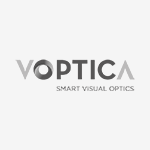Purpose: LASIK allows not only to correct for the refractive error but also to extend depth of focus by inducing controlled amounts of spherical aberration (SA). However the success of the procedure may depend on the particular SA values required by each patient. We have used a customization procedure to optimize the values of SA to induce for each patient by using an adaptive optics vision analyzer before the surgery.
Methods: A group of 47 hyperopic/presbyopic patients were evaluated before and after surgery using the Adaptive Optics Vision Analyzer (AOVA, Voptica SL, Murcia, Spain). It is a clinical instrument to perform vision testing with full control of the optical aberrations induced in the patient’s eye non-invasively. The AOVA includes a wave-front sensor to measure refraction and aberrations, a liquid crystal on silicon spatial light modulator to induce any desired aberration profile on the patient’ s eye, and a micro-display to present the visual stimuli to the patient. Visual acuity was measured for defined combinations of residual defocus and SA (in steps of 0.05 microns for a 4.5-mm pupil) at infinity, 60 cm and 40 cm. In each patient, the sets of optimized values of defocus and SA required to find the better near and far VA were determined. Then, the LASIK treatment was settled to induce additional negative asphericity in the non dominant eye. The fellow (dominant) eye was treated to reach emmetropia without inducing supplementary SA.
Results: The average Q-value changed from -0.1 to -0.5 in the dominant eyes, and from -0.05 to -0.65 (p<0.001) in the eyes treated for inducing extra asphericity. The average value of SA providing an extended depth of focus was around -0.28 microns for 4.5-mm pupil. In these eyes, after surgery, the required positive addition for intermediate and near vision was +0.33 and +1.0 respectively for non dominant eyes and +0.7 and +1.3 for dominant eyes (p<0.001). The postoperative aberrometric data were compared and correlated to the optimized SA value predicted.
Conclusions: Hyperopic/presbyopic patients were ideal candidates for customized LASIK to induce an extended depth of focus. This procedure can be optimized when mediated with adaptive to predict the right amount of SA to be induced. These results suggest that the LASIK guided with an AOVA is a promising strategy to improve visual outcomes.
Methods: A group of 47 hyperopic/presbyopic patients were evaluated before and after surgery using the Adaptive Optics Vision Analyzer (AOVA, Voptica SL, Murcia, Spain). It is a clinical instrument to perform vision testing with full control of the optical aberrations induced in the patient’s eye non-invasively. The AOVA includes a wave-front sensor to measure refraction and aberrations, a liquid crystal on silicon spatial light modulator to induce any desired aberration profile on the patient’ s eye, and a micro-display to present the visual stimuli to the patient. Visual acuity was measured for defined combinations of residual defocus and SA (in steps of 0.05 microns for a 4.5-mm pupil) at infinity, 60 cm and 40 cm. In each patient, the sets of optimized values of defocus and SA required to find the better near and far VA were determined. Then, the LASIK treatment was settled to induce additional negative asphericity in the non dominant eye. The fellow (dominant) eye was treated to reach emmetropia without inducing supplementary SA.
Results: The average Q-value changed from -0.1 to -0.5 in the dominant eyes, and from -0.05 to -0.65 (p<0.001) in the eyes treated for inducing extra asphericity. The average value of SA providing an extended depth of focus was around -0.28 microns for 4.5-mm pupil. In these eyes, after surgery, the required positive addition for intermediate and near vision was +0.33 and +1.0 respectively for non dominant eyes and +0.7 and +1.3 for dominant eyes (p<0.001). The postoperative aberrometric data were compared and correlated to the optimized SA value predicted.
Conclusions: Hyperopic/presbyopic patients were ideal candidates for customized LASIK to induce an extended depth of focus. This procedure can be optimized when mediated with adaptive to predict the right amount of SA to be induced. These results suggest that the LASIK guided with an AOVA is a promising strategy to improve visual outcomes.


